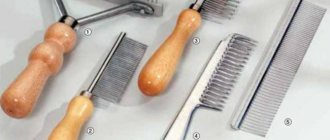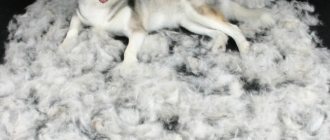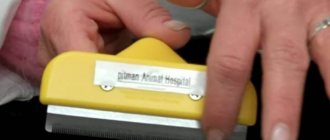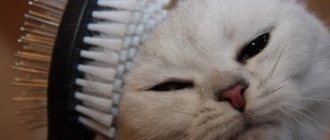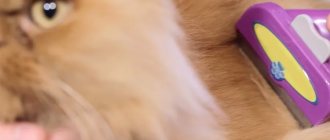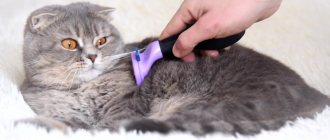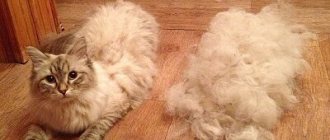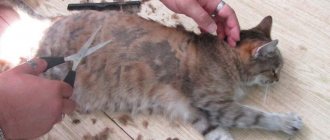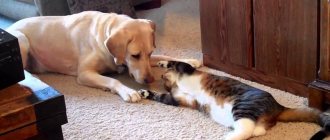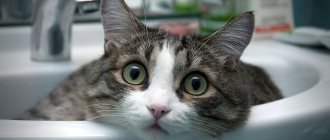Almost all cat owners, except for the lucky owners of Sphynx cats, sooner or later wonder: how to comb a cat and is this procedure really necessary for a pet?
Wool is a real barometer of a cat's health and mood. Smooth and shiny speaks of excellent health and excellent state of mind. Dull and disheveled - that the animal is sick or sad. To restore a cat to its former beauty, hygiene procedures alone are not enough. However, by combing her fur with the right tools and caring for her, you will help your pet cope with her illness much faster.
Do I need to comb my cat?
In the first weeks and even months after a kitten (especially a short-haired one) appears in the house, few people think about the fact that it needs to be combed. But then the inevitable happens: the baby begins to shed. The carpet in the living room, the furniture, your trousers - everything is covered with an even layer of wool. With disgust, catching another suspicious hair from a bowl of soup, you are thinking about whether to vacuum this little bastard, and with great interest you watch the work of the groomers on the TV screen.
If it's +30° outside in the shade, a short haircut can only benefit your pet. At other times of the year, you can tidy up his coat yourself. You just need to master the basics and accustom your cat to such procedures.
Daily brushing will not only help speed up the shedding process. This is a pleasant massage that causes the animal to purr contentedly. After this procedure, the coat becomes smooth, shiny, and the cat looks healthy and well-groomed.
It is especially important to accustom a long-haired cat to a comb and brush. The tangles in which the deprived fur gets tangled do not at all decorate the animal. This is an excellent nest for fleas, fungi, and various types of infections. Once wet, the mat does not dry for a very long time. The skin underneath becomes inflamed and red. In addition, there is a danger that the mat will get caught on something and, trying to free itself, the animal will cause severe pain to itself. In the future, the cat will be afraid of any touch and will avoid procedures aimed at combing or cutting off the mat. But in order to save your pet from suffering, it is enough to regularly comb his fur coat!
Not all animals are calm about the brushing procedure, especially those who have already had negative experiences with a brush. Their owners do not want to expose their hands to sharp claws; they prefer to vacuum the floor in the apartment once again, leaving the animal to take care of its fur on its own. However, such connivance is fraught with the risk that the cat will sooner or later begin to regurgitate swallowed hair. If the intestines become clogged, you will have to take her to the clinic. You can, of course, offer your cat a paste that is intended to remove hair from the body that accumulates there during daily washing. But it is better to deal with large amounts of shed fur using combs and brushes.
Regularity of the procedure
The cat licks itself several times a day. If you do not comb your pet, very serious consequences can occur. While licking itself, the animal swallows a lot of hairs. They enter the digestive tract, and then the cat often vomits hairballs. An even more serious problem will arise if the intestines become clogged with accumulated hair. This may cause intestinal obstruction and require surgery.
Another problem for cat owners is tangles in which hairs get stuck. Long-haired pets especially often suffer from this.
For your information! Only an experienced specialist should cut tangles, because this procedure requires accuracy and skill.
Grooming your cats will help keep your home clean. There will be much less wool left on bedspreads, carpets and chairs, and you won’t have to clean the apartment too often. Obviously, only very irresponsible owners do not know how to brush a cat and why it should be done.
A thick undercoat helps the body retain more heat. Happy owners of long hair and a thick undercoat need constant brushing. Such animals need to be combed daily. For short-haired dogs, once a week is sufficient.
What and how to comb a cat's hair and undercoat during shedding?
If your pet has a short coat, brushing it will not cause you any problems. Two or three procedures a week are enough to ensure that the animal does not scatter tufts of fur everywhere and looks beautiful and neat. For a cat with long hair (Persian, Angora) this is not enough. You will have to comb him at least four times a week, or better yet, every day.
To care for your pet's fur, you may need the following items:
- furminator;
- brush-mitten;
- cylindrical brush;
- your tender, loving hands.
Rule one: from tail to head
The guard hairs and soft undercoat should be combed in the direction opposite to the growth of the coat. This will help rid your pet of excess hair much faster.
Rule two: from rare to frequent
You need to start brushing your furry pet with a wide-toothed brush, then change it to one with more teeth. You need to complete the procedure with a brush with the most frequent tooth arrangement. Finally, take a cylindrical brush and use it to collect the combed wool.
Rule three: smooth the curls
In order to collect all the hairs from the surface of the cat’s body, a set of brushes is not enough. Prepare a bowl of warm water, sit your pet on your lap, wet your hand and run it through the cat's fur. There will be a lot of “unaccounted” hairs left on the palm. Rinse your hand and repeat your steps. Do this as many times as necessary so that not a single lint remains on your palm. Many cat owners neglect this simple manipulation, and in vain.
Sometimes it can be difficult to reach certain places with a comb. It's much easier to do this with a damp hand. You can also “comb” small kittens without the help of a brush.
Frequency of use and benefits of products
This event is recommended to be carried out once or twice a month for British cat breeds. In summer, using a furminator will carefully remove excess undercoat. It is also necessary to comb out during the molting period - the beginning of spring and autumn - two to three times a week. Advantages of Furminators for a Briton:
With this device you don’t have to resort to cutting the animal.
- Reducing the amount of hair falling out, minimizing mats and mats.
- Savings on visits to grooming salons.
- Due to the correct distribution of fatty lubricant, the appearance of the animal's fur coat is significantly improved - it becomes beautiful and shiny.
- Easier cleaning due to reduced amount of hair loss.
Thus, each cat owner himself chooses what is best for a furry animal - a comb for a British cat, a brush-mitten, or simply removing hair with a damp cloth - after all, the main thing is that the care is correct. That’s why it’s so important to carefully care for your pet’s fur coat - he, in turn, will not remain in debt and will repay you with love for your care.
Slicker comb: the most popular
In order to comb out dead fluff without affecting the strong guard fibers, you will need a so-called slicker, or slicker.
The peculiarity of the slicker is in its teeth. They are metal, thin, with a characteristic bend. Depending on the quality of your pet’s coat, you need to choose a slicker brush: the thicker and longer the coat, the longer and more frequent its teeth.
You should not try to deal with matted hair using a slicker. It is intended only for the care of healthy hair, previously combed with a wide-tooth comb.
When your cat sheds, refrain from brushing her coat with a slicker every day. Twice a week will be enough. More frequent use will turn your fluffy beauty into a pitiful, shabby creature. After the shedding period ends, use this useful tool once a week.
Despite the popularity of the slicker, it is only one of many tools needed to care for your pet.
Brush selection
A brush for combing cat hair should be selected depending on the length and type of fur. A different set of brushes will be needed for long-haired and short-haired pets, as well as for their Scottish counterparts. Outbred cats can also be short-haired or long-haired. Their coat also needs good care.
Long-haired pets
Luxurious hair needs to be well looked after. A caring owner should pay especially much attention to combing long-haired and semi-long-haired cats. These breeds include Persians, Maine Coons, Kuril Bobtails, Turkish Angora, Neva Masquerade, Burmese, Siberian, Norwegian Forest and many other cats. For them you will need at least three combs with teeth of different lengths:
- with short and frequent;
- with averages;
- with long and sparse ones.
You need to carefully care for your furry pet's luxurious coat, so you also need to purchase an anti-tangle spray, conditioner, a brush with natural bristles, and talcum powder.
Mitten: the easiest to use
If your pet doesn't like combs and slickers, try using another tool popular among cat owners - a rubber mitten.
Short or long teeth, located at different frequencies on the surface of the mitten, perfectly massage the skin of the animal. Thanks to this, blood circulation improves, the hair follicles are strengthened, and the coat becomes healthy and shiny. Cats love this massage very much. It can be carried out both on dry wool and during water procedures. Of course, one mitten cannot replace a whole set of combs, combs and brushes, but if your pet categorically objects to the use of other tools, it is still better than nothing.
Types of wool
Different breeds of cats have different lengths and thicknesses of fur, which means that they will need to be cared for differently. If your pet has short hairs, then the procedure is practically not required; you can use a mitten.
To answer the question of how to comb a long-haired cat, you should first familiarize yourself with how to do it correctly. The procedure will take a lot of time and needs to be done frequently. The same rule applies to cats with semi-long hair. If your pet has an undercoat, then it must be combed with special care.
Furminators
One of the most popular tools for combing cat hair is the furminator.
Small rake with frequently set teeth - this is what this miracle tool looks like.
Furminators for cats are divided into two types: classic and deluxe. They differ in design and width of the ridges.
For small kittens, a 3.2 cm wide comb is suitable.
For small cats whose weight does not exceed 5 kg, a comb width of 4 and a half cm is sufficient.
The most popular width of the comb, which can be used not only in caring for a cat, but also for a small dog, is 6.8 cm.
Regardless of the width of the comb, furminators come with short and long teeth, which allows you to use them when caring for a cat of almost any breed. The only exceptions are those breeds whose coat is devoid of undercoat or has a specific shape: Devon Rex and Cornish Rex, Burmans, Singaporeans, Orientals, Turkish Angoras and some others.
If there are scratches or wounds on the animal’s body, as well as in the case of any skin disease, the furminator should not be used!
Anyone who has ever used a furminator notes that the cat’s hair loss has been significantly reduced, and its appearance becomes much better due to the fact that the fatty lubricant is distributed more evenly. Furminators are used by professional groomers, but nothing prevents you from mastering this tool yourself and providing your striped “Murka in a jacket” with the same care as an overseas beauty worth more than one thousand dollars.
Why are tangles dangerous?
if you ignore the formation of tangles, this can affect the health of your pet
Mats spoil the appearance of your pet. They make the cat look untidy. Professional breeders can ruin their reputation if a purebred cat looks unkempt. And even if the pet is a simple domestic cat, but with tangles, it will be unpleasant to stroke it. However, in addition to not being aesthetically pleasing, pets with mats are at risk of diseases:
- germs and parasites;
- dermatological problems;
- the cat may damage its skin.
Mats can form from wool that is wet (with saliva), and in the form of a lump, the wool will not be able to dry at all. This saliva can harbor parasites and germs. Their activity on the animal's skin can lead to dermatological problems. And the same problems can arise without exposure to parasites. The skin under the mat will become hot and overheat. Experiencing severe itching and discomfort, the cat will try to scratch its skin and remove mats. This way, the cat can damage its skin with its claws and teeth, and the resulting scratches can become infected.
How to comb a short-haired cat?
Most short-haired cat breeds do not require much grooming. Once every six to seven days is enough for your Siamese, Abyssinian or Burmese pet to look perfect.
To care for short hair, you need a short-toothed comb and a soft rubber brush.
Run the comb several times from the scruff to the tail, then in the opposite direction. Massage your pet's skin with a rubber brush, smooth the fur first with a brush and then with your hand. Your pussy looks great!
DIY haircut
Animals with thick fur need to be trimmed periodically, as hair clumps can sometimes form, causing some discomfort. It is not always possible to comb such areas, and taking the animal to the hairdresser will be expensive, so many people prefer to carry out the process themselves. Grooming cats at home should be carried out according to certain rules:
- First, you will need to shorten your pet’s claws a little, using a nail clipper.
- For the first time, it is better to invite a specialist who knows how to properly hold an animal to carry out the procedure, and it will be easier to deal with a four-legged friend. The cat lies on its side and holds on to its paws.
- Next, you should arm yourself with a clipper and carefully cut the wool. After the sides are finished, move on to the back and front. It is very important to act extremely carefully, since there are nipples on the stomach.
- In order not to injure your pet, it is better to cut off the lumps using scissors, since doing this with a clipper will be problematic, and the cat will become nervous.
- To avoid cutting the animal, it is necessary to stretch the creature's skin.
- At the end of the procedure, you will need to wash the cat using clean water, after which it is dried with a hairdryer.
If the animal is always at home, then haircut can be done at any time. However, this does not apply to pets that are occasionally outdoors. Such cats need to be clipped only before the summer season.
How to comb a British cat?
The British are short-haired animals. Their thick coat of fur is certainly easier to care for than the coat of a Persian or Ragamafine, but not as easy as a Siamese. A comb with short teeth will be completely useless for a Briton, and with frequent teeth it will inevitably damage the dense undercoat, without which the animal will lose its well-fed teddy bear appearance. Using a slicker brush to care for a Briton is simply barbaric. Resourceful owners prefer to collect the faded fur of their thick-cheeked pets with wet hands. Surprisingly, they can pick up much more hair than the best brush.
Of course, we are talking only about daily home care. Animals that take part in international exhibitions use the services of professional groomers. In their care, products are used that strengthen the coat, giving it shine and silkiness.
Some care tips
If you are interested in how to properly comb a cat, then you should know certain rules that you should follow. Thanks to them, caring for your pet will become much easier. Experts recommend sticking to some basics:
- To really help your pet, you should make brushing a regular procedure.
- The choice of comb must be made based on the characteristics of the coat.
- The process must be carried out based on the length and thickness of the hairs.
- Accustoming to manipulation is done at a young age, and it is better in a playful way.
- It is advisable to avoid the appearance of tangles, and if they form, remove them with great care.
- During the procedure, it is necessary to examine your pet in order to get rid of existing problems in a timely manner.
It is important that the cat is in a good mood; it should not break out during the brushing period. If the animal twitches and struggles, then a positive result cannot be expected. This can only lead to tufts of fur being pulled out or your pet's skin being damaged. In addition, the cat will remember this procedure for a long time, which means it will be afraid of it.
How to comb a Scottish cat?
Caring for the coat of a Scottish Fold or Scottish Straight cat is not very difficult. Perhaps it is even easier to comb out than any other. The fact is that the fur coat of charming tartans lies in both directions, like mole fur. You can completely calmly stroke your pet against the grain without encountering any objections from her. On the contrary, the Scottish one will calmly bask in your arms, offering her neck for scratching.
Like any other cat, they begin to comb the Scottish cat with a sparse comb in the direction from the tail to the head, collecting dead hair, then change the direction. The procedure is completed with a natural bristle brush, which gives the animal’s fur smoothness and unique gloss. When a cat sheds, you can additionally collect fur from it with wet hands. Usually, a thorough combing is enough for her.
